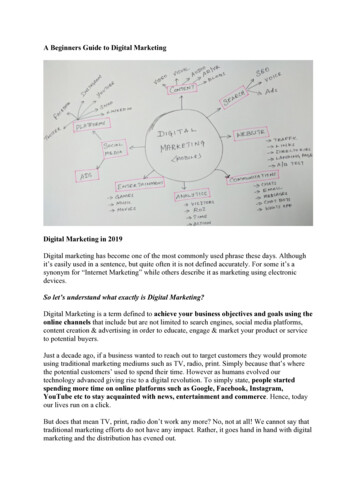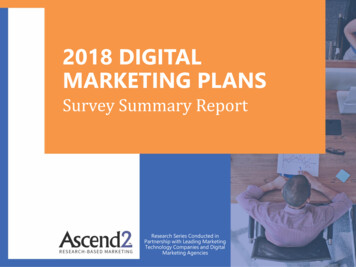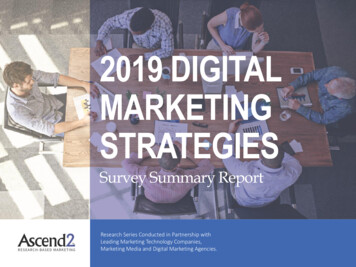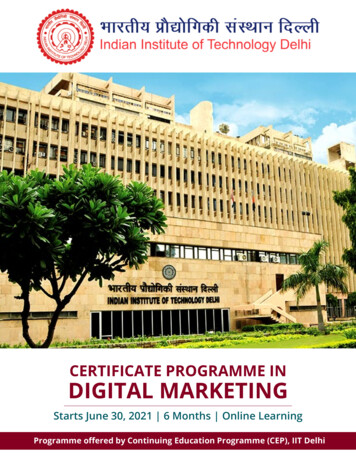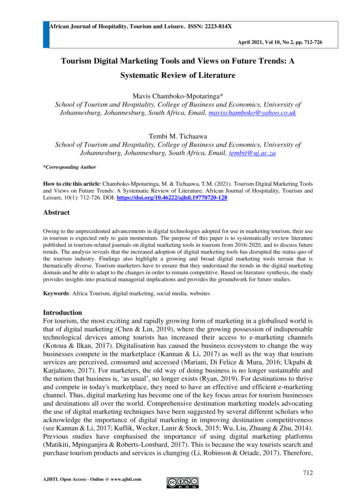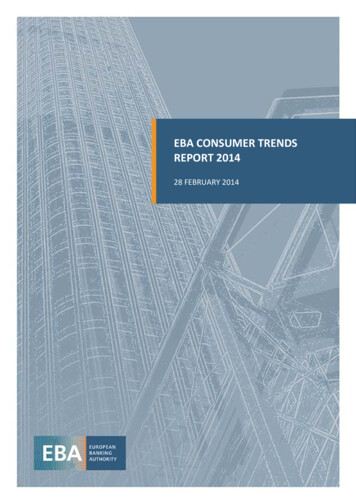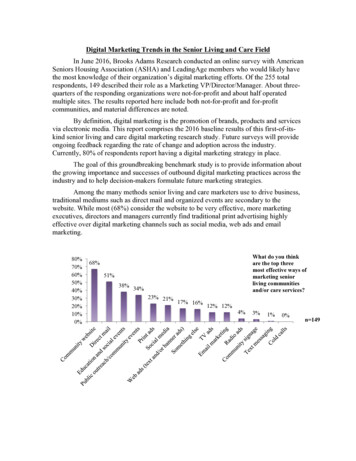
Transcription
Digital Marketing Trends in the Senior Living and Care FieldIn June 2016, Brooks Adams Research conducted an online survey with AmericanSeniors Housing Association (ASHA) and LeadingAge members who would likely havethe most knowledge of their organization’s digital marketing efforts. Of the 255 totalrespondents, 149 described their role as a Marketing VP/Director/Manager. About threequarters of the responding organizations were not-for-profit and about half operatedmultiple sites. The results reported here include both not-for-profit and for-profitcommunities, and material differences are noted.By definition, digital marketing is the promotion of brands, products and servicesvia electronic media. This report comprises the 2016 baseline results of this first-of-itskind senior living and care digital marketing research study. Future surveys will provideongoing feedback regarding the rate of change and adoption across the industry.Currently, 80% of respondents report having a digital marketing strategy in place.The goal of this groundbreaking benchmark study is to provide information aboutthe growing importance and successes of outbound digital marketing practices across theindustry and to help decision-makers formulate future marketing strategies.Among the many methods senior living and care marketers use to drive business,traditional mediums such as direct mail and organized events are secondary to thewebsite. While most (68%) consider the website to be very effective, more marketingexecutives, directors and managers currently find traditional print advertising highlyeffective over digital marketing channels such as social media, web ads and emailmarketing.80%70%60%50%40%30%20%10%0%What do you thinkare the top threemost effective ways ofmarketing seniorliving communitiesand/or care services?68%51%38%34%23% 21%17% 16%12% 12%4%3%1%0%n 149
Currently, 42% of the organizations deploy monthly email blasts/newsletters,16% send them out weekly and 16% send them out quarterly.How often does your organization send out email campaigns such as e-blastsand newsletters?NeverEvery dayWeeklyMonthlyQuarterlyLess frequently than quarterlyPercentage9%3%16%42%16%15%n 120Table does not total 100% due to roundingWhile few answered the question, all of those who did agreed that Facebook wasthe most effective social media platform, followed by Twitter and LinkedIn.Social media platforms that you think are the most effectiveFacebookTwitterLinkedInInstagramSomething elseDon’t knowPercentage100%31%24%14%7%0%n 29Approximately half of the organizations that were surveyed currently use calltracking technology (53%). About a third of respondents (36%) reported using dedicatedcall tracking telephone numbers to follow the success of both their offline and digitalsources of telephone inquiries; 11% use only digital sources and 6% use only offlinesources.Use dedicated call tracking numbers to track the success of offline and/ordigital sources of your telephone inquiriesNo, we do not use dedicated call tracking technologyYes, both offline and digital sourcesYes, but only digital sourcesYes, but only offline sourcesDon’t knowPercentage47%36%11%6%0%n 146
Use dedicated call tracking numbers to track thesuccess of offline and/or digital sources of yourtelephone inquiriesYes, both offline and digital sourcesNo, we do not use dedicated call tracking technologyYes, but only offline sourcesYes, but only digital 3%22%11%4%28%57%5%10%For-profit providers are significantly more likely to be using both offline anddigital sources while not-for-profit providers are less likely to use call trackingtechnology at all.Increasing lead generation (78%), brand awareness (58%) and sales (53%) top thelist of senior living marketers’ primary goals. The lead-to-tour rate of conversion fromdigital marketing was reported at an average of 20%, and the lead-to-sale rate ofconversion from digital marketing was at an average of 7%.Approximately half of visitors access a community or care organization’s websitewith a desktop computer (51%) spending 1-3 minutes (54%) and typically viewing 1-3pages per session (54%). Live chat is not widely utilized. Only 11% of the communitiesor organizations currently have a live chat feature on their website.Relatively few visitors currently access websites via mobile phone (28%) or tablet(21%), but these percentages are expected to grow as greater numbers of the baby boomgeneration, who are heavy users of mobile technology, interact with a parent or lovedone’s community or caregiver and increasingly seek information about senior living andcare services for themselves.What is the average time a viewer spends on your website?Less than 1 minute1 to 3 minutes4 to 6 minutes7 to 8 minutesMore than 8 minutesDon’t knowPercentage1%54%20%4%2%19%n 138What is the average number of pages viewed per session on your website?123456 or moreDon’t knowPercentage1%11%42%13%3%4%26%n 137
All the organizations have a website and about four out of five (78%) utilize search enginemarketing with the most success. Social media, email and display ads are also widely useddigital marketing tactics, but these have yet to reach high levels of effectiveness.100%100%81%80%60%40%28%Engage in81%What kinds of digitalmarketing activities doyou engage in and howeffective are they?Effective92%78%72%75%33%61%35%43%20%n 1080%Email Organization Display adsSearch Social media ion management is viewed as an important component of digitalmarketing strategy. Three-quarters of respondents (75%) are actively managing theirreputation online. Most engage a third-party provider, but many use a reputationmanagement platform to help them respond promptly to online reviews and comments.Others self-monitor review websites such as Google , Yelp, Facebook and Caring.comand encourage staff and residents to post positive reviews on the organization’s behalf.Some have hired a dedicated reputation management employee to monitor and respond tocomments. For-profit providers are more likely to be managing their reputation onlinethan not-for-profit providers, but not significantly.Are you actively managing your reputation online?PercentageYesNoDon’t know75%22%3%n 108Actively Managing Reputation OnlineNot-For-Profit ProvidersFor-Profit Providers70%92%
Three quarters (75%) of respondents reported using up to 40% of their overallmarketing budget on digital marketing efforts; with most companies spending 25,000 orless on digital marketing.The largest percentage of annual digital marketing budget for 2016 was allocatedto Google AdWords at an average of 20% and social media ads at an average of 13%.What percentage of your overall marketing budget is currently spent ondigital marketing activities?0-20%21-40%41-60%61-80%81-100%Don’t knowPercentage43%32%9%7%2%7%n 105What is your current overall yearly budget spent on digital marketingactivities? 0- 10k 11k- 25k 26k- 50k 51k- 75k 76k- 100k 101k- 150kOver 151kDon’t knowPercentage21%17%11%12%7%7%14%11%n 103Percent of Budget Spent on Digital Marketing50%40%30%42%44%29%20%10%10%0%For-Profit Providers0 to 25KNot-For-Profit ProvidersOver 100K
Significantly more for-profit providers spend at least 100,000 per year on digitalmarketing than not-for-profit providers.For-Profit8%21%4%4%8%13%29%13% 0- 10k 11k- 25k 26k- 50k 51k- 75k 76k- 100k 101k- 150kOver 151kDon’t knowNot-For-Profit27%17%13%16%6%4%6%11%Nearly two-thirds of the respondents (64%) anticipate spending more on digitalmarketing activities in 2017; only 1% anticipate spending less.2017 Spending GoalsDon’tknow5%Less in20171%Just aboutthe sameamount asin 201630%More in201764%n 106Most respondents see room for improvement as their strategies begin to bear fruit. Aboutfour out of five (79%) grade their current digital marketing plan a B or C for beingsuccessful in achieving their organization’s goals, and three out of five perceive theirdigital marketing presence to be worse than their competitors (61%).How do you grade your current digital marketing plan’s success ofachieving your organization's goals?ABCDFDon’t knowPercentage10%48%31%8%1%2%n 106
How do youperceive yourdigital marketingpresence comparesto your keycompetitors?n 107Strategy execution is the biggest challenge for most of the organizations (30%) followedby tech savviness (24%).Inadequate budget and inability to integrate with a CRM (Customer RelationshipManagement system) were noted as the top two barriers to digital marketing. Not-ForProfit providers were more likely to cite inadequate budget.What aspect of digital marketing is your organization’s biggest challenge?PercentageProcess – Having the means and methods to carry out strategyKnowledge – Having the understanding to capitalize on technologyData – Having access and control over customer and marketing application dataTechnology – Having the tools to use data to create personalization in real time30%24%17%14%n 118Table does not total 100% due to removal of “Don’t know” responsesInability to integrate with Don't know / no opinionInadequate reporting 2%1%1%Lack of technologyInadequate internal skills0%5%9%8%7%6%14%20%19%What is yourorganization’smost significantbarrier to digitalmarketingsuccess?n 11810%15%20%25%
Marketing automation technologies facilitate automated tasks from the marketingand sales process including lead nurturing, prospect profiling, lead scoring and deliveringpersonalized content to maximize consumer engagement.Just under half (45%) of the respondent organizations are either exploringmarketing automation technology used for delivering personalized marketing content atkey touchpoints in the customer’s journey or will implement it in the future; 39% are notexploring or unaware, and 16% are currently using it.What best describes your organization’s approach to marketing automationtechnology used for delivering personalized marketing content at keytouchpoints in the customer journey?We are using that technology todayWe anticipate having this technology in place for 2017We are exploring this technology but have no set date for implementingWe are not yet exploring this technologyDon’t know/unaware of this technologyPercentage16%13%32%29%10%n 120In conclusion, as digital marketing practices in the senior living and care industryevolve and mature in the coming years, challenges will include having the means andprocesses to ensure digital marketing strategies are carried out efficiently and having the
understanding necessary to take advantage of trends and technology. Adoption will growto include greater percentages of overall marketing budgets. Smaller organizations willtake steps to improve their knowledge, while larger organizations will work onstreamlining digital marketing processes.Our industry will develop stronger one-on-one consumer relationships forgedthrough marketing automation activities and online reputation management. In 2017, theindustry can expect greater engagement through email marketing, online leadmanagement and relationship-building activities, CRM integration for better customerengagement and increasing marketing and sales opportunities.The American Seniors Housing Association (ASHA), LeadingAge and BrooksAdams Research thank all who participated in this important study to understandoutbound digital practices and trends in the senior living industry.
marketing budget on digital marketing efforts; with most companies spending 25,000 or less on digital marketing. The largest percentage of annual digital marketing budget for 2016 was allocated to Google AdWords at an average of 20% and social media ads at an average of 13%. What percentage of your overall marketing budget is currently spent on



